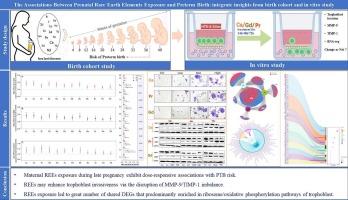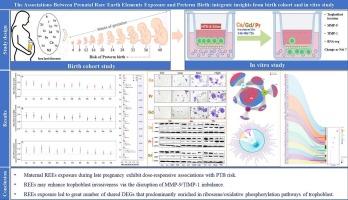The associations between prenatal rare earth elements exposure and preterm birth: integrate insights from birth cohort and in vitro study
IF 9.7
1区 环境科学与生态学
Q1 ENVIRONMENTAL SCIENCES
引用次数: 0
Abstract
Rare earth elements (REEs) are emerging environmental contaminants, yet their effects on preterm birth (PTB) remain poorly understood. This study integrates epidemiological and mechanistic evidence to evaluate REEs-associated PTB risk and potential biological pathways. We analyzed 4,897 mother–child pairs from a large cohort in China and 13 REEs in maternal urine were measured. PTB risk was assessed via logistic regression and weighted quantile sum (WQS) models. HTR-8/SVneo trophoblasts were used to evaluate cell invasion (Transwell assays), matrix metalloproteinase-9(MMP-9)/ tissue inhibitor of matrix metalloproteinase-1 (TIMP-1) expression (western blot), and transcriptomic profiles (RNA-seq) after REEs treatment. Median concentrations (0.006–0.065 μg/g creatinine) and detection frequencies (90–100 %) of 12 REEs were higher in PTB cases (P < 0.05). Each log2-unit increase in individual and mixture of REEs exposure elevated PTB risk by 18–51 % after adjusting for covariates. Cerium (Ce), praseodymium (Pr) and gadolinium (Gd) were the primary contributors. Environmentally-relevant REEs concentrations (0.5–100 μg/L) treatment enhanced trophoblast invasion by 2.7–19.2 folds, accompanied by MMP-9 upregulation and TIMP-1 suppression in dose-dependently. Transcriptome analysis revealed 1,425 shared differentially expressed genes, prominently affecting ribosome biogenesis and oxidative phosphorylation pathways. These findings establish REEs as hazardous environmental contaminants impacting maternal-fetal health, providing crucial evidence for reevaluating exposure guidelines.


产前稀土元素暴露与早产之间的关系:来自出生队列和体外研究的综合见解
稀土元素(ree)是新兴的环境污染物,但其对早产(PTB)的影响仍知之甚少。本研究综合了流行病学和机制证据,以评估rees相关的PTB风险和潜在的生物学途径。我们分析了来自中国一个大型队列的4897对母子,并测量了产妇尿液中的13种稀土元素。通过logistic回归和加权分位数和(WQS)模型评估PTB风险。利用HTR-8/SVneo滋养细胞检测稀土元素处理后的细胞侵袭(Transwell实验)、基质金属蛋白酶-9(MMP-9)/基质金属蛋白酶-1组织抑制剂(TIMP-1)表达(western blot)和转录组学(RNA-seq)。12种稀土元素的中位浓度(0.006 ~ 0.065 μg/g肌酐)和检出率(90 ~ 100 %)在肺结核患者中较高(P <; 0.05)。在调整协变量后,个体和混合稀土暴露每增加log2个单位,PTB风险就会增加18-51 %。铈(Ce)、镨(Pr)和钆(Gd)是主要贡献者。环境相关稀土浓度(0.5 ~ 100 μg/L)处理可使滋养细胞侵袭增强2.7 ~ 19.2倍,并伴有MMP-9上调和TIMP-1的剂量依赖性抑制。转录组分析显示1425个共享差异表达基因,显著影响核糖体生物发生和氧化磷酸化途径。这些发现确定稀土元素是影响母胎健康的有害环境污染物,为重新评估暴露指南提供了重要证据。
本文章由计算机程序翻译,如有差异,请以英文原文为准。
求助全文
约1分钟内获得全文
求助全文
来源期刊

Environment International
环境科学-环境科学
CiteScore
21.90
自引率
3.40%
发文量
734
审稿时长
2.8 months
期刊介绍:
Environmental Health publishes manuscripts focusing on critical aspects of environmental and occupational medicine, including studies in toxicology and epidemiology, to illuminate the human health implications of exposure to environmental hazards. The journal adopts an open-access model and practices open peer review.
It caters to scientists and practitioners across all environmental science domains, directly or indirectly impacting human health and well-being. With a commitment to enhancing the prevention of environmentally-related health risks, Environmental Health serves as a public health journal for the community and scientists engaged in matters of public health significance concerning the environment.
 求助内容:
求助内容: 应助结果提醒方式:
应助结果提醒方式:


